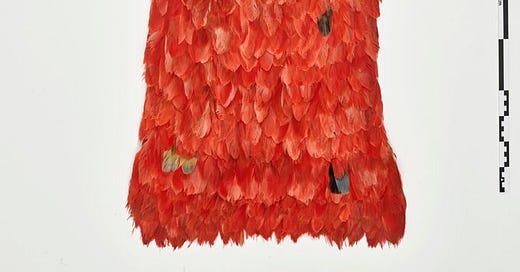The Return of the Tupinambá Cloak
After the complete destruction by fire of the National Museum of Brazil, the rebuilding will require return of artifacts from around the world. The indigenous people of Brazil make their point.
The Danish National Museum has returned an important indigenous relic to Brazil. A 300-year old scarlet ibis feather cloak that has been been held at the museum was handed over to the new Museu Nacional/UFRJ in Rio de Janeiro earlier this summer. Not to the indigenous tribe that claims ancestral ownership to it, the Tupinambá of Olivença, but in agreement with them after some struggle and negotiations.
The Tupinambá feather cloak before transport to Brazil the second time. Photo: Roberto Fortuna, the National Museum of Denmark.
It is not known how the cloak ended up in Danish custody. “We can only see that in 1689 it was registered in the inventory of the Royal Art Gallery. But there has been a lot of speculation about how it got there, says Christian Pedersen, senior researcher at the Danish National Museum. (Nationalmuseet) It has been in permanent display at the Danish museum and has been studied by different scholars over the years.
Worldwide, there are by now only 11 such Tupinambá feather cloaks, all of which are in European museums, and the one in Copenhagen is among the best preserved. The National Museum's collection in Denmark actually hold five of the feather coats.
The iconic feather cloak is permanently transferred to Brazil's national museum Museu Nacional in Rio de Janeiro as a "significant and unique contribution" from the Danish side to the reconstruction of the Brazilian museum, which lost its collection in a devastating fire in September 2018.
The fire at Rio de Janeiro’s 200-year-old National Museum began after it closed to the public on Sunday and raged into the night. There were no reports of injuries, but the loss to Brazilian science, history and culture was incalculable, two of its vice-directors said.
“It was the biggest natural history museum in Latin America. We have invaluable collections. Collections that are over 100 years old,” Cristiana Serejo, one of the museum’s vice-directors, told the G1 news site. (The Guardian)
Museu Nacional in Rio de Janeiro the day after the fire in 2018. Photo: globo.com
The Tupinambá people were among the first indigenous peoples encountered by Europeans upon arrival on the east coast of Brazil. The living Tupinambá express joy that their ceremonial plumage is now coming back to Brazil, where it will be part of the national storytelling in the national museum.
After receiving the letter from Rane Willerslev, director of Denmark's National Museum, Tupinambá leader Babau said: “For us, the donation of the Tupinambá cloak means that an ancestor is returning! It is also an immortal hope that returns: a concrete answer to those who believe in the strength of their people and continue to fight for their culture, secrets and religion. We continue to create other cloaks. But now, by a generous donation, our greatest relic will return to Brazil! The bird that symbolizes this cloak, the ibis, which is no longer found in our region, is born and turns gray. When they eat crabs, their feathers turn red. It is a sign of the transformation that is happening in everything, people and their culture. Many thanks to the National Museums in Brazil and Denmark for allowing us to hear the sacred words of our ancestors again. The cape is back!” (Nationalmuseet)
When the Portuguese arrived in eastern Brazil in 1500, they encountered the Tupi-speaking people, including Tupinambá. They were considered a fierce tribe and initially tended to side with the Portuguese against other tribes, but the encounter with the Europeans and their diseases was a hard blow for them and led to a great decline in the population.
In 2001, the Tupinambá people were recognized as indigenous people in Brazil under the designation Tupinambá de Olivença and were allowed to regain some farmland. The population lives in southern Bahia and today probably numbers around 4,600 people spread over a number of villages.
The Cultural magazine C& for Latin America describes the return process, mentioning first that the feather cloak initially returned on temporary loan conditions, for the 500 year exhibition in Brazil. Seeing it at the exhibition inspired the Tupinambá to demand that the cloak remain in Brazil, but they were not able to prevent the return to Denmark.
Attributed primarily to “increased awareness” on the part of the Danish Museum’s director and international relations with the Brazilian government, the process to make the restitution of the splendid scarlet ibis feather cloak official went on for two years and took place in secrecy, as described by Elisangela Roxo in her article The Return of the Tupinambá Mantle (published by Revista Piauí on June 27, 2023). Among the various national and international agents involved, the article highlights the role of Brazil’s ambassador to Denmark, Rodrigo A. Santos, who, during the repatriation process, contacted and forwarded letters from leaders of the Tupinambá de Olivença Indigenous Reserve, located in Ilhéus, Buerarema and Una, in the state of Bahia. (C& Latin America)
Engraving by Theodor de Bry, 16th century. Reproduction: “The First Peoples of Brazil” Exhibition, National Museum (UFRJ). Source: osPrimeirosBrasileiros







Return all those precious artefacts so that they can burn again? Really?